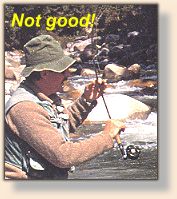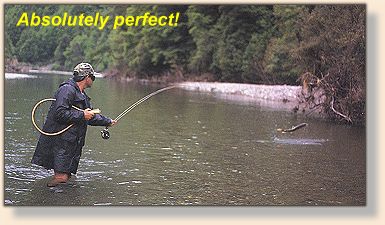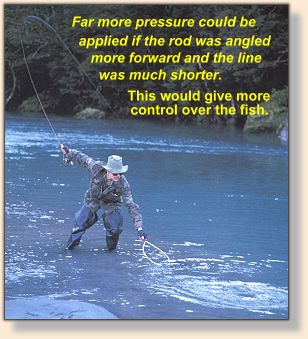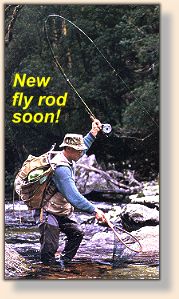|
Picture that you have a nice fish on your fly
rod. (We can always picture that!) The fish is swimming downstream.
You are trying to reel it in. (You do always put the fish on the reel
as soon as possible right?) Somewhere there is an old wives tale
about always keeping your rod tip up. Do you have more control
over the fish by having your rod tip up - or by pointing the rod
straight at the fish?
Let's give this a little thought.
The fish hits your fly and you haul your rod tip up. Right? Opps,
not exactly. If you are fishing for small fish, lifting your
rod tip is enough to set the hook. Setting the hook on trout is best
done by the fish! When the fish takes the fly, the fish will turn.
Wait for that turn! Then lift (not haul back) the rod tip. If you
lift the rod tip too soon you pull the fly out of his mouth. And
say "ah, he missed it!" He didn't miss it, you did.
For larger fish, you don't lift the rod tip much, if at all. The best way
is to line-strike the fish. That is use your line hand, not the rod hand,
and give the line a couple of short, sharp tugs. If you have line laying
on the water at that point, guide the line onto your reel. Don't just
crank like mad or you risk having a bloody mess of snarls if the fish
makes a major run. With some fish getting the line on the reel isn't
a question, the fish will take it all before you can get it on the reel.
Does that say anything about controlling your 'loose' line?
Ok, the fish is on! Now what.
Small fish can be reeled in, if the fish makes a run, terrific (that is fun) -
but don't lift your rod over your head making a big bend in the rod,
(unless it is advisable to keep the line off the water for drag, weeds
or mangrove reasons). Do not move your rod hand up the rod,
off the cork handle in order to get more leverage on the fish.

If you have a long stick, and you want to break it, how would you
do that? Say you have a campfire, and the stick is a couple of inches
in diameter, it won't fit on the fire nicely. No, not the axe. I would
probably put my knee in the middle of the stick, hold onto
each end with my hands, and pull both ends of the stick toward me.
Sound about right? If you move your hand up the rod, you have the same
principals at work as the example of how to break the stick. The rod will break!
If the fish runs usually only raise your rod no more than 30 degrees
from the water. Once the fish stops, raise the rod, never more than 70
degrees from the water, and reel in as you lower the rod back down.
Do not point your rod tip straight up and expect to apply any pressure
to the fish. It might look great in T.V. pictures, (you notice they lose
a lot of fish doing exactly that,) but it isn't at all effective.

Big fish? And it jumps? When the fish comes out of the water, drop your
rod tip immediately! This is called 'bowing to the fish' - what it does is
put a little slack in the line so the fish can't break the leader at this point.
Or if the fish falls on your line, it won't be so tight as to break. Don't
just stand there with your mouth open! Drop the rod tip!
There are varying opinions on where your rod tip should be pointed when
fighting a fish, and this may differ for various species too. Some feel if
you point your rod in the opposite direction the fish is going you will
confuse the fish. (This only works on short lines as the angle won't
change if the fish is way out. An example of where it does work is
from a boat with a full sinking short line, with saltwater fish. I've
whipped jack crevalle successfully with this method). The fish is
usually so far out (all my line and most of my backing) that just the
drag of the line itself produces as much stress on the fish as it is
possible to do. If you can manage to keep a tight line on the fish,
you can land it. With multiple runs by the fish, each run tends to
be shorter, with you regaining line each time. Even a very strong
fish can be landed with steady pressure and patience.
You do need to know what the drag adjustment on your reel does.
I usually start out with just enough tension so I can pull line off the
reel without the reel spinning and making a squirrel's nest. When I
get a fish on, I can loosen the drag a little, (I do this a little
at a time - not doing this may cause the leader to break) if the fish is
still taking line and I'm seeing parts of the arbor I really don't want
to see, I will loosen it a little more. As the line goes out it actually
increases the drag on the fish. Not only by water friction, but the spool gets
smaller increasing the drag too. You can also apply more drag by
'palming' your reel. This only works on reels which have an exposed
rim, and is done by pressing the palm (or fingers) of your line hand
against the exposed bottom rim of the reel. Try it gently! Too much
will break the fish off. (It can also produce a skin burn, especially
on big fish really moving out.)

In fresh water streams and rivers, as well as the salt, a fish can require
you to move! Be prepared to get below where the fish is, or
where it is headed. Do not expect to stand in one spot and not move.
If you apply pressure to the fish, by either continuing to reel in line
and/or by directing the fishes movement to where you want it to go,
you will shorten the battle. Your object as a fly fisher is to land
(and/or release) the fish as quickly as possible. Unless you are
float tubing in a lake - (which is another story) there should be no
difficulty in directing the fish toward the bank where you can land it.
 Even on very large fish, once toward the shore, a little pressure will
cause the fish to swim, or flop to a point where it has almost landed
itself. When landing the fish, keep your rod arm straight! And keep
yourself between the fish and the reel. Do not bend your elbow.
Doing so will help keep you from breaking the rod tip. It's that sharp
angle caused at the point of landing the fish (shown on the left,)
which will break a rod.
Even on very large fish, once toward the shore, a little pressure will
cause the fish to swim, or flop to a point where it has almost landed
itself. When landing the fish, keep your rod arm straight! And keep
yourself between the fish and the reel. Do not bend your elbow.
Doing so will help keep you from breaking the rod tip. It's that sharp
angle caused at the point of landing the fish (shown on the left,)
which will break a rod.
I've caught a lot of fish, varying kinds of fish, and seen lots more caught.
Maybe the best piece of advice I can give you, if you are in doubt as what
to do, point your rod at the fish. Take a deep breath, and plan your actions.
Fishing isn't just about the right fly to hook the fish or good casting. You
need to be mentally prepared. If the fish takes your fly, where will it go?
How do you get there? How will you get the fish out of there? Are there
weed beds, brush piles, snags, rocks? How about deep runs or pools?
What is the strategy you will use?
Yes! You hooked the fish - now what? ~ LadyFisher
Credits: The images used on this column are from Images of Silver
by Les Hill and Graeme Marshall, Published by Halcyon Press, Auckland NZ.
Captions used are ours.
|






 Even on very large fish, once toward the shore, a little pressure will
cause the fish to swim, or flop to a point where it has almost landed
itself. When landing the fish, keep your rod arm straight! And keep
yourself between the fish and the reel. Do not bend your elbow.
Doing so will help keep you from breaking the rod tip. It's that sharp
angle caused at the point of landing the fish (shown on the left,)
which will break a rod.
Even on very large fish, once toward the shore, a little pressure will
cause the fish to swim, or flop to a point where it has almost landed
itself. When landing the fish, keep your rod arm straight! And keep
yourself between the fish and the reel. Do not bend your elbow.
Doing so will help keep you from breaking the rod tip. It's that sharp
angle caused at the point of landing the fish (shown on the left,)
which will break a rod.